FLCL: Volume 1 (UK) (DVD)
Introduction
It could be said that we in the UK really get the cream of the anime crop, as after the US distributors cherry pick the most impressive shows of those released in Japan, we get a further winnowing of the chaff before the shows eventually make it to the UK. That's rarely the case though, as demographics and populist choices will influence distributors who need a profit. So we see fewer niche titles, fewer of those shows that garner critical acclaim instead of large audiences than you would think. Time is also an influence, as leaving a licence hanging for more than a couple of years practically kills it, as word of mouth and fan momentum would have died down. Sometimes peeking into a Region 1 anime forum is like wandering into another world, with more than half of the titles being raved about, titles that have never made it to UK Region 2. Lurking on those forums and seeing the love expressed for shows like Kimagure Orange Road, Captain Herlock, Space Pirate, Prince of Tennis, Maison Ikkoku, and Desert Punk makes me lament the size of the UK market. They're like strange, mysterious gems, full of wonder and beauty and lamentably out of reach for UK customers unwilling to import and wary of straying into shadier areas of the Interweb.
But once in a blue moon, patience turns out to be a virtue. FLCL is a show that still gets more love and more forum bytes than you would expect for a show that is 8 years old. It's been six years since it was originally released in the US, and I'm sure everyone with an interest in the show would have given up on a UK release by now. But once in a while, Charlie does indeed find the last Golden Ticket to the Chocolate Factory. I've been stretching my anticipation for this show to breaking point…
Adolescent ennui takes centre stage in FLCL, with 12-year-old Naota resident in a quiet dead-end town whose only point of interest is a giant steam iron of a factory that regularly pumps fumes out over the town. His older brother is in America playing baseball, and he's left behind reflecting on the dreariness of existence in a town where nothing ever happens. He spends his time hanging out with his brother's girlfriend Mamimi, although since he left, Mamimi, who is at something of a loose end and lacking many friends of her own age, has been showing a rather oppressive interest in Naota. And the days slowly pass by…
Until one day, a girl on a scooter appears carrying a bass guitar. She introduces herself by running down Naota, and then reviving him with some indecently applied mouth to mouth, only to clout him once more with the guitar. Her name is Haruko, and she claims to be an alien. And nothing will ever be the same again. Soon, she's piloting her Vespa into Naota's dad, in order to move in ostensibly as a housekeeper, but more to keep an eye on Naota. For suddenly, Naota's brain has vanished and he's sprouted a horn in the middle of his forehead. Only it's not a horn, it's actually a robot trying to get out!
The first volume of FLCL contains 2 episodes and a host of extra features.
Picture
With two years invested in making just 6 episodes of animation, you would expect something special, especially from the combination of GAINAX (Evangelion) and Studio I.G. (Ghost In The Shell), and you won't be disappointed with FLCL. The transfer is excellent, with the 4:3 image coming across with absolute clarity and depth of colour. The only time you will notice any aliasing or compression artefacts is if you pause the disc; in normal playback it looks excellent. There are also no signs of NTSC-PAL transfer issues. I'd be hard pressed to distinguish it from a native PAL transfer.
The animation itself is astounding. One criticism of anime that is occasionally justified is that it isn't always that animated, with creators using tricks to make static scenes look dynamic, with plenty of talking heads and pretty landscapes, as well as a lower frame count to save on the budget and the sanity of the animators. There's none of that with FLCL. I have never seen television animation from Japan so dynamic and vibrant. The animation is fluid and of a constant high frame rate. There is always motion on screen, something to marvel at, and there is an energy to the characters and the onscreen action that indicates a theatrical level budget.
Sound
You have a choice between DD 2.0 English and Japanese with optional subtitles and signs. The dialogue is clear in both versions and the stereo offers a nice degree of separation to the effects. The music is something special, with a soundtrack commissioned from the Japanese rock group, The Pillows, and diverse enough to warrant three official soundtrack CDs. The English dub has stood up well to the test of time, and sounds just as well performed and solid today, when compared to current efforts. I of course opted for the original language track, and personally I found that the American accents didn't suit the animation as well.
Extras
A painfully low episode count is mitigated somewhat by the extra features, offering more than the usual anime disc gets, beyond the animated menus, jacket picture and trailers (Black Lagoon and Love Hina Again).
Both episodes get a commentary from director Kazuya Tsurumaki, interviewed by two unnamed commentators. He talks volubly about the show, the characters and the points of interest therein. It's a clear, informative commentary that is light and easy to listen to, a valuable addition to the disc. Note that you have to select it from the Setup menu, as it isn't listed in the Extras. This is subtitled in English quite naturally.
The Pillows Film Clip lasts 2½-minutes, and offers the music video to the end theme in full.
There are 19 images in a Character Sketch gallery, the Japanese promo to the show lasts 3 minutes, the Japanese Closing Credits are there, and there are Cast Profiles for two of the characters.
Not listed in the extras, but available through your remote is a fourth audio track. It's an effects and music only track, which offers you the chance to hear those tunes from The Pillows without anyone talking over them. Occasionally tracks like this have been given gimmick titles, such as 'Dub Your Own Show', but in this instance it turns out to be a tantalising option. I'd love to hear FLCL with a British dub.
Conclusion
That's the thing that struck me about FLCL. It's very British, if you can ignore the obvious anime trademarks, the character designs and the Japanese dialogue. But in several ways it is unique. The sense of humour has a wry darkness to it, a bizarre surrealism and nihilistic tone that to me is very British. There are hints in the character and world design that speak much to me of 90s British pop culture, and the music soundtrack with its emphasis on guitars and meaningful lyrics says Britpop more than anything else. If I didn't know any better, I'd swear that Jamie Hewlett of Gorillaz fame had a hand in the show. Haruko certainly has a Tank Girl sensibility to her.
FLCL manages to capture that disillusionment of adolescence with wry observation. Naota and Mamimi live in a town where they believe that nothing ever happens, and nothing ever will happen. They're the ones that life left behind, quite literally so in some ways as Naota's brother has hit the big time and escaped the humdrum life to play baseball in America. Naota has conflicted feelings about this, a sense of betrayal coupled with a lingering admiration for his brother. Mamimi went out with Naota's brother, and is at a loose end now that he is gone. She spends most of her time with Naota, has something of an uncomfortable attachment to him, as if Naota is a connection to his brother. It makes it difficult for twelve-year-old Naota, who is just beginning to see girls in a different way, while being concerned about how he appears to others. Seventeen-year-old Manimi is practically a misfit, an outcast in her school, with no one but Naota to hang out with, and while Naota does have friends, he's more apt to spend time with Mamimi, watching the planes fly over.
It's into this dead end existence that Haruko comes with a crash, a force of nature that enters Naota's life and changes everything. She's a sort of demented minx, a self-proclaimed alien that is in town looking for something, and thinks she's found it in Naota. Smacking him over the head with a bass guitar elicits an odd reaction, when a simple bump transforms into what looks like a horn. Naota's brain is missing, and from the void that is left, robots are climbing out, robots that have something to do with the Medical Mechanica factory in town.
The second episode focuses more on Mamimi, and that destructive urge that outcast teens express in a cry to be noticed. There is an arsonist loose about town, has been once since Naota's old school burnt down. Meanwhile Mamimi is looking for divinity, and seems to have found it in Canti, the first robot to climb out of Naota's head, and who has now joined Naota's household as a general gofer around the house. When a second robot appears, the two robots wind up fighting each other, and twisting anime conventions that require a robot to gain strength from a human pilot, Canti needs a human element to give him go-faster stripes. How he gets that element is utterly weird.
Actually, writing about FLCL is beginning to hurt my head. It's bizarre, surreal and unlike anything I have seen before. It has story arcs running through it, but does more by invoking mood and feeling. It seems more important to get the characters rather than understand the plot. Yet the plot does make a modicum of sense when you think about it. It's definitely a show that demands repeat viewings. I watched it twice in a row and I still don't think I've picked up on everything. Yet it is the most inventive, effective animation that I have seen in quite a while. There is a mix of styles and an utter freedom of creativity that renders it a joy to watch. In the middle of the first episode, a rather static talking heads scene is given amazing life by expressing it through manga panels. It's as if you are reading the manga, with the camera moving from panel to panel, yet there is animation in each frame as well, making it look like the pictures on the page are actually moving. The freewheeling approach to the animation, coupled with the distinctive soundtrack makes FLCL instantly memorable. The depth of characterisation, coupled with the anarchic, fast-paced story puts the show into the lofty instant classic category.
The only thing holding it back is the release format. MVM are restricted by the licence stipulations, meaning that they have to release it in the same format as the US. Their recent price cut goes some way to mitigating this, as do the copious extras on the disc, but just two episodes to a disc seem a little too frugal. Two volumes of three would have been better, or perhaps just jumping straight to the inevitable boxset. Still, two episodes of FLCL are worth a whole series of Black Cat and a damn sight more. Bite the bullet and buy this series, regardless of whether or not you are an anime fan, because the sheer energy of this show will more than reward your investment.


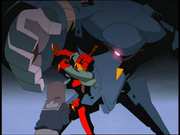


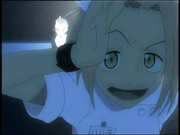


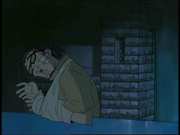
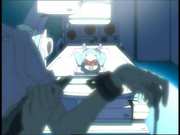

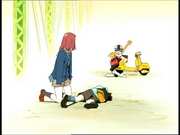
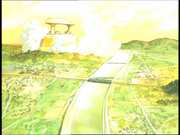







































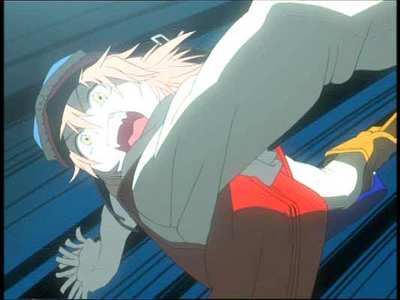
Your Opinions and Comments
Be the first to post a comment!